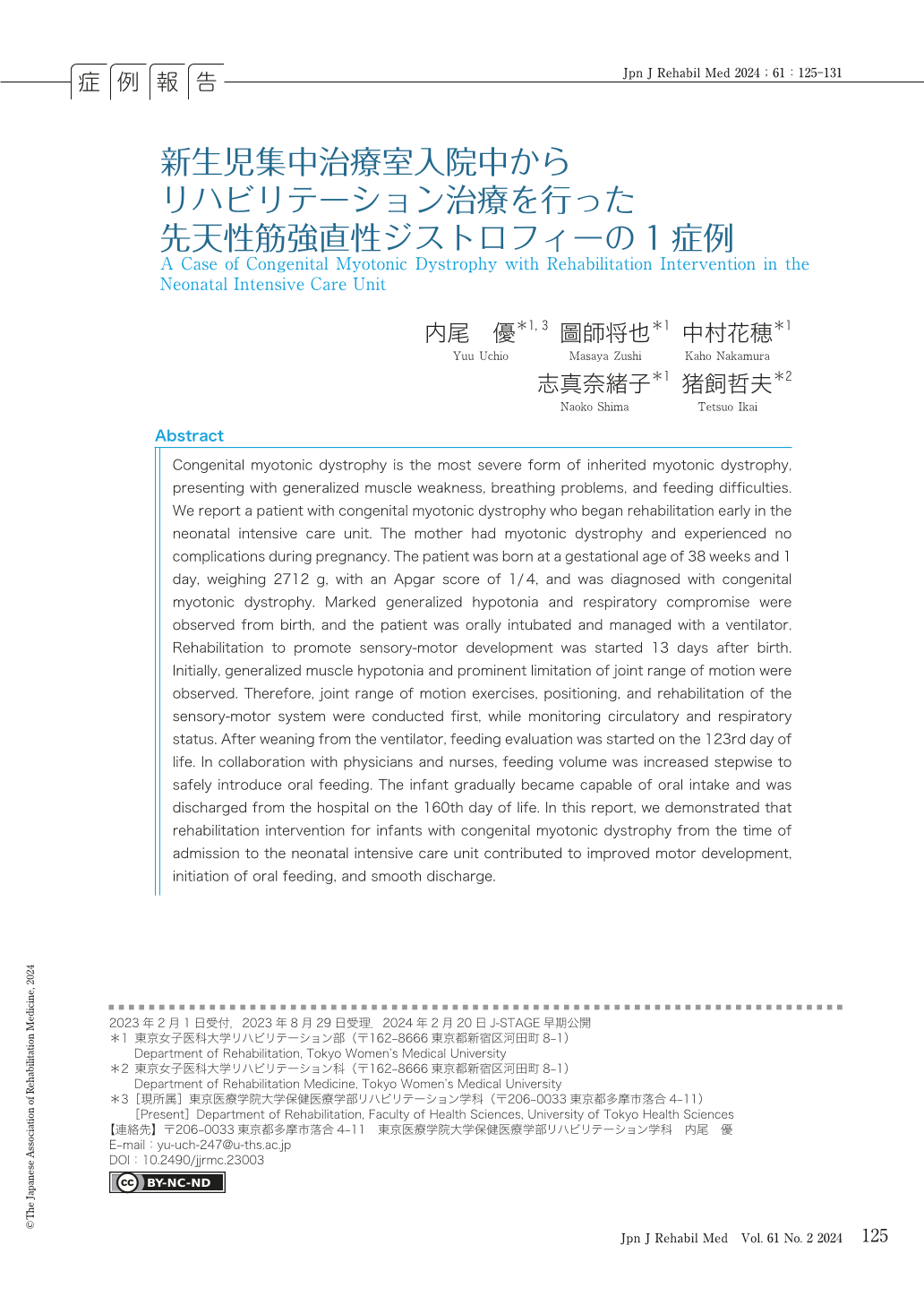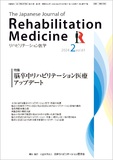Japanese
English
- 販売していません
- Abstract 文献概要
- 1ページ目 Look Inside
- 参考文献 Reference
はじめに
筋強直性ジストロフィー(myotonic dystrophy:DM)は,常染色体顕性遺伝(優性遺伝)による遺伝性疾患である1).DMはmyotonic dystrophy protein kinase(DMPK)遺伝子の異常繰り返し配列2)の異常伸長を認める筋強直性ジストロフィー1型(myotonic dystrophy type 1:DM1)とcellular retroviral nucleic acid binding protein遺伝子に異常伸長を認める2型に分類される.DM1の中で,出生時より症状を認める先天性筋強直性ジストロフィー(congenital myotonic dystrophy:CDM)は,その最重症型とされ,2型での報告はない.CDMの症状は,全身の筋緊張低下・筋力低下,呼吸障害,哺乳障害,精神発達遅滞を呈す.有病率は,DM全体において世界的には10万人あたり8.3〜10人とされ3, 4),本邦では2.7〜9.7人と報告されている5, 6).死亡率は生後4週以内の新生児期が最大40%であり,その原因の多くが呼吸不全である1, 7).なお,DM1においてはDMPK遺伝子の異常繰り返し配列が長くなると症状は重症となり,発症年齢が早まる傾向がある.異常繰り返し配列の長さは親子で同じではなく世代を経るごとに長く,発症が早く重症となる傾向があり,これは表現促進現象と呼ばれる.
CDMは出生時から症状を認め,多関節に及ぶ拘縮や長期人工呼吸器管理,哺乳障害が問題となることから新生児集中治療室(neonatal intensive care unit:NICU)入院中の時期から医学的管理・治療に加え注意深いリハビリテーション評価・治療が必要である.
本邦においてCDMに対するリハビリテーション治療の報告は,幼児期以降の尖足に対する術後の報告8)や学齢期の呼吸理学療法の報告9)などがなされているものの,出生後早期からNICUにおいてリハビリテーション治療を記録したものは非常に限られる.今回,CDMにより出生後からNICUでの継続的な治療を要し,早期からリハビリテーション評価・介入,家族指導を行うことにより,円滑な在宅および外来へ移行したと考えられた症例を経験したので報告する.なお,本論文の投稿においては,ご家族へ本報告の趣旨,内容について文書と口頭にて十分な説明を行い,書面にて同意を得た.
Abstract Congenital myotonic dystrophy is the most severe form of inherited myotonic dystrophy, presenting with generalized muscle weakness, breathing problems, and feeding difficulties. We report a patient with congenital myotonic dystrophy who began rehabilitation early in the neonatal intensive care unit. The mother had myotonic dystrophy and experienced no complications during pregnancy. The patient was born at a gestational age of 38 weeks and 1 day, weighing 2712 g, with an Apgar score of 1/4, and was diagnosed with congenital myotonic dystrophy. Marked generalized hypotonia and respiratory compromise were observed from birth, and the patient was orally intubated and managed with a ventilator. Rehabilitation to promote sensory-motor development was started 13 days after birth. Initially, generalized muscle hypotonia and prominent limitation of joint range of motion were observed. Therefore, joint range of motion exercises, positioning, and rehabilitation of the sensory-motor system were conducted first, while monitoring circulatory and respiratory status. After weaning from the ventilator, feeding evaluation was started on the 123rd day of life. In collaboration with physicians and nurses, feeding volume was increased stepwise to safely introduce oral feeding. The infant gradually became capable of oral intake and was discharged from the hospital on the 160th day of life. In this report, we demonstrated that rehabilitation intervention for infants with congenital myotonic dystrophy from the time of admission to the neonatal intensive care unit contributed to improved motor development, initiation of oral feeding, and smooth discharge.

Copyright © 2024, The Japanese Association of Rehabilitation Medicine. All rights reserved.


